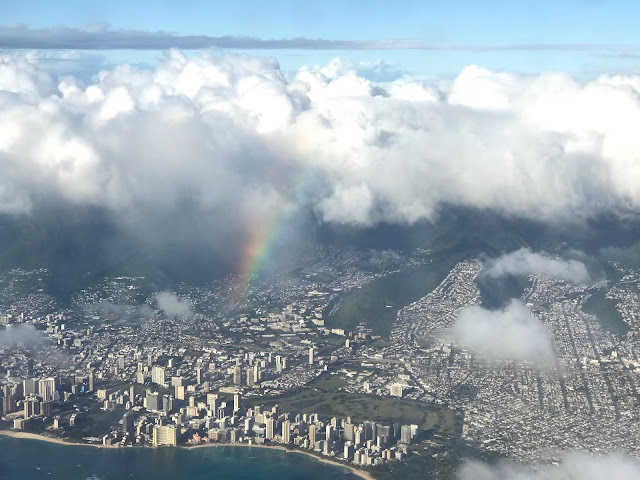Yup. Itʻs raining. Though a few minutes ago, shadows were seen as the sun shone...now its raining again, adding to our 8 or 9 inch (or more) accumulation since Sunday. Whatʻs a few more inches? Right here we need not worry about flooding, though elsewhere...
Late last week I went Oahu for an appointment with an excellent custom-fabricating orthotist, seeking to acquire an updated Ankle Foot Orthotic (AFO) to compensate for post-polio weakening of right leg... Cameron is excellent and insightful, my issues complex, so we collaborate and heʻs working on v2. Now at home in quarantine, I get tested tomorrow, and we shall see...
The Honolulu airport was eerily empty, making travel a breeze...though a cautiously care full one. Pics below were taken Saturday afternoon. You get the idea... Had even fewer people Wednesday last.
Traveling during a time of rains winds and changeable weathers I noted, with pleasure, a multiplicity of ānuenue...rainbows seemingly everywhere.
From the window of the hotel,
to the runway as we taxied,
to one hanging over the mouth of the valley of Mānoa (and had plenty rains earlier, so please note the green of Waʻahila hillside to right of ʻbow).
Being a look-out-the-window sorta guy, I was enthralled by fleeting ānuenue sunlit (of course) in rain falling from little cumulus clouds. So. Very. Cool.
And then, up at the Lua, this, posted by HVO on January 6, 2012. A he nani maoli nō. So beauty full. Can you make out the partial double between 12 and 2?
I never tire admiring them. And they always bring to mind "Hawaiian Lullaby", that soothingly evocative song by Hector Venegas and Peter Moon.
So very beautifully expressive, simply touching...
Kinda tough to find a suitable segue...
So yes. Rainbows do not happen without rain. And rain on hot pele is fascinatingly hotsteamy. Below, during ka ua loku, torrential downpours yesterday, Halemaʻumaʻu was filled with steam. Hot steam. The centigrade scale: 50dC = 122dF, thus the purple background. In the Park, people have died after being unexpectedly enveloped by hot steam out on active flows.
Below this morning, a more "normal" view. I note that the moku nui and the north side of lake crust are more or less same temperature, and appear to merge as one.
Steams swirl as seen below at 950 this morning,
but at 1003 the pit is cleared. When we worked at active flows on the coast, squalls would come in from the ocean. Weʻd see them approach and move visitors safely away from hot pele to avoid scalding māhu. Even from a distance, weʻd envision rain evaporating before hitting active pele.
Below, walls of Halemaʻumaʻu steam vigorously, and many little steam plumes arise from the slightly cooler crust of the loko ahi to the right of moku nui. On the left side of the floor, the paler grey pele is fresh hot and moving, with little apparent steam. Way too hot for māhu to linger!
Back at home...I was watching the rain from the kitchen window yesterday, and was fascinated. A small thing, but significant, I think. We understand that rain is how our watertables and aquifers are replenished. Rain falls, soaks into the earth, and makes its way down down down. I have a ti, planted by my Dad decades ago. The stalk is taller than I am, and partway up is a clump of moss. I watched for minutes yesterday, water dripping to the ground from the moss.
Rain fell (falls) on the rosette of lau kī (ti leaves), and is directed to bases of stems via a furrow or trough as seen a bit more clearly at the right on the lower photo.
 |
| amazon |
 |
| charlotte flower market |
Rain slides down the leaf, into the groove, then flows down the trunk, into the ground. On days like today when ka ua loku prevails, itʻs wet everywhere. But Iʻd guess that during drier seasons, or in drier areas such as the uplands of Kona ʻAkau (North Kona), moisture from sprinkles of rain or even heavy dew will find its way down the leaf, through the furrow, down the trunk, and into soil, aiding kī survival. A tiny window into a much much bigger picture of water, water procurement, water use, and groundwater recharge.
Stay dry, stay warm, be well. [As I just typed the last, I recalled: camping at Maniniʻōwali, sometimes it would rain. The rain would be chilly. Rather than attempting to stay dry, weʻd go bob in the sea. Compared to rain, the ocean was warm, and so were we...]
Hiki? A hui hou. As always, with aloha,
BobbyC
maniniowali@gmail.com

















aia i hea ka wai a Kāne? aia i ka lāʻī!
ReplyDelete